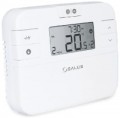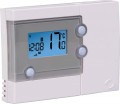Hysteresis
Automatic temperature control hysteresis provided by the device.
Hysteresis can be described as the difference between the on and off temperatures of a system controlled by a thermostat. Usually, the permissible deviations of the actual temperature from the nominal one in one direction or another are half the hysteresis. So, at a set temperature of 22 °C and a
hysteresis of 0.5 °C, the controller will turn on the heating as soon as the room temperature drops to 21.75 °C, and turn it off when it rises to 22.25 °C. Accordingly, the lower this indicator, the more carefully the temperature is maintained and the fewer fluctuations. On the other hand, small hysteresis values require accurate and expensive thermal sensors, increase fuel/energy consumption and wear of the entire system, and create an increased risk of false alarms (for example, from a cool draft on the thermal sensor). In addition, relatively small temperature fluctuations are practically imperceptible in terms of human comfort. Therefore, many modern thermostats have a
hysteresis of 1 °C — this, usually, is quite enough for domestic use.
Also note that this parameter can be both
fixed and
adjustable. The first option is simpler and cheaper, and the second provides additional options for setting the thermostat to the specifics of the situation.
Programmable cycles per day
The largest number of individual cycles that the thermostat timer can set in one day.
The cycle is the period during which the thermostat operates on one set of settings. For example, if there are 2 cycles, you can provide turning off the heating while you are at work and turn it on shortly before returning home. However, most thermostats provide a noticeably larger number of cycles — up to 24.
Note that in weekly timers (see "Timer type") this parameter may differ depending on the day of the week. For example, weekdays usually have more extensive settings than weekends.
Features
—
Display. The presence of its own screen in the design of the regulator. Such a screen is usually a simple LCD matrix with segment digits. However, even on such a screen, very diverse data can be displayed (including temperature with an accuracy of fractions of a degree), and this function significantly expands the capabilities of the thermostat and makes it more convenient. Note that it makes sense to install the display primarily in electronic models (see "Device type"), for such thermostats it is almost mandatory (but in mechanical ones, on the contrary, it is almost never used).
—
Protection of the pump from "souring". During non-working hours — for example, between heating seasons — deposits can form on the parts of the circulation pump of the heating system, which can make it difficult to rotate the impeller, reduce the efficiency of the pump, or even disable it altogether. This phenomenon is called "souring". To avoid it, automatic regulators may provide protection against acidification: periodically (once every few weeks) the pump is turned on for a short time, which prevents the formation of deposits (and removes those that have already formed).
—
Holiday function. A special regime provided for in case of a long absence of people in the house (for example, during a vacation — hence the name). In holiday mode, you can set a certain temperature to
...be maintained for several days (for example, a week; the maximum duration depends on the thermostat model). At the same time, in some models, this function is combined with frost protection (see below) and allows you to set only the minimum temperature (usually 5 °C); in others, the holiday temperature can be programmed.
— Random mode. A mode that provides for the inclusion of various heating functions in a random order (but without causing critical loads on the heating system). The most popular use of this feature is to simulate that someone is at home; this can stop intruders planning a theft in the absence of the owners.
— Management via the Internet. Ability to control the controller via the Internet. The device itself is usually connected to the network via Wi-Fi, and the control features may be different. For example, in some models you need to use a proprietary application installed on a smartphone or tablet, in others it is enough to open a special page in any browser. However, anyway, this function allows you to control the heating system remotely, from anywhere in the world. This can be extremely convenient in unforeseen situations — for example, if during the absence of the owner on the street it gets warmer. In addition, additional features such as advanced timer programming may be available with Internet control.
— Frost protection. A function that prevents freezing of the coolant in heating systems. Freezing water expands, which can lead to mechanical damage and depressurization of the system. To avoid this, regulators with this function are able to "monitor" that the temperature of the coolant does not fall below 5 °C, and, if necessary, turn on the heating to maintain the temperature. This function is relevant primarily for cases when the disconnected heating system must be left unattended for a long time during the cold season.
— Protection from children (blocking). The ability to lock the control panel of the regulator so that a curious little child cannot knock down its settings. The lock, usually, is turned on and off in such a way that an adult, but not a child, can easily do it — for example, by simultaneously pressing certain keys.
— Heater operating hours counter. Built-in counter that tracks the total heating time. This feature makes it much easier to keep track of the operating mode and heat costs, eliminating the need for the user to keep records manually and allowing you to track working hours even when there is no one nearby.
— Sensor calibration t. Possibility to calibrate the temperature sensor of the thermostat. In fact, situations may arise when the readings of the temperature sensor for one reason or another differ from the actual temperature in the room — for example, the controller is installed near an electrical appliance that generates heat and knocks down the setting, and neither device can be moved. For such cases, calibration is provided — an amendment to the readings of the temperature sensor. For example, if the thermometer in the middle of the room reads 20°C and the regulator's sensor reads 22°C, you can correct the thermostat to -2°C and the temperature displayed on the regulator will correspond to the true temperature. Of course, the correction can also be taken "in the mind" without reconfiguring the device; however, most often it is easier to set the necessary parameters in advance and not get confused in the calculations.
